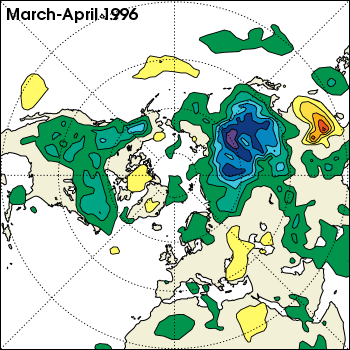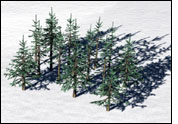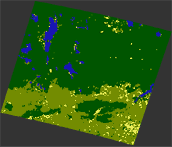Betts and
his BOREAS colleagues observed that, in the spring, daily weather
forecasts significantly underestimated air temperatures over the boreal
forest, sometimes by as much as 10—15°C (18—27°F) (Viterbo and
Betts, 1999). Additionally, the BOREAS team found that predictions of
cloud cover over the boreal region were often far off the mark.
Everyone complains about the weather, but how could the forecasts be so
wrong so often?
|
|
|
 The scientists noticed
a pattern that confirmed their earlier suspicions: the temperature
forecasts were farthest off in late spring
when snow was on the ground and grew more accurate after the snow
melted. From summer through fall, the weather models matched actual
measurements more closely (Betts et al. 1998). But the following year, come
springtime, the forecasts again became increasingly inaccurate until
snow melted. Why were the weather forecasts so inaccurate every
spring?
…BOREAS Did Something About The Forecasts
Comparing actual BOREAS data with two different forecast
models—one developed by the National Centers for Environment
Prediction (NCEP), and the other developed by the European Centre for
Medium-Range Weather Forecasts (ECMWF)—the BOREAS team found that
the models were overestimating albedo (the amount of light
reflected by the surface). The models assumed that in the springtime,
the boreal landscape is still covered by snow and therefore has a high
albedo (reflects most of the sunlight). In reality, Betts observes,
while snow is still typically on the ground in May, it lies under the
forest canopy, which is green and therefore has a low albedo (absorbs
most of the sunlight).
|
This
map shows the average errors in the European Centre for Medium-Range Weather Forecasts
at 850mb (roughly equivalent to an altitude of 1500m) for March and April of 1996. The predictions, made
five days in advance, were compared to actual measurements. The 1996 model did not include the adjustments to
forest albedo.
(Figure from Viterbo, P. and A.K. Betts, 1999:
The impact on ECMWF forecasts of changes to the albedo of the boreal forests in the presence of snow. J. Geophys.
Res. (In press, BOREAS special issue). Courtesy A.K. Betts) 
|
 How could meteorologists have made this mistake? Betts explains that
in mid-winter the models were fairly accurate because the angle of the
sun is low relative to the horizon (about 20 degrees), days are shorter,
and the amount of incoming sunlight is small. Occasionally after
snowfall, snow also remains in the canopy for a few days and reflects
more sunlight. Yet in May, when the sun angle is higher and days are
longer, there is more sunlight and no snow in the canopy to reflect it.
Consequently, the canopy in dense forest regions intercepts most of the
incoming sunlight, while the snow on the ground below is shaded. How could meteorologists have made this mistake? Betts explains that
in mid-winter the models were fairly accurate because the angle of the
sun is low relative to the horizon (about 20 degrees), days are shorter,
and the amount of incoming sunlight is small. Occasionally after
snowfall, snow also remains in the canopy for a few days and reflects
more sunlight. Yet in May, when the sun angle is higher and days are
longer, there is more sunlight and no snow in the canopy to reflect it.
Consequently, the canopy in dense forest regions intercepts most of the
incoming sunlight, while the snow on the ground below is shaded.
|
Trees in the Boreal forest shade
the snow underneath them. The effect is more significant than it is in southern latitudes because the sun is so low in the
sky, creating very long shadows. |
| "Fresh snow on grass reflects about 80 percent of the sun’s
light and absorbs 20 percent," Betts states. "The more
sunlight that is reflected back up into the atmosphere, the cooler the
surface temperatures. On the other hand, conifer trees (e.g., spruce
and pine) reflect only 10 percent of the sun’s energy and absorb
the rest, warming the surface and transferring the heat back to the
atmosphere."
Yet the global forecast models used by NCEP and ECMWF treated the
boreal forests in the spring as if they were snow-covered grasslands
with an albedo of 60—80 percent, instead of forests with snow under the
trees with an albedo of 10-20%. The models estimated that the boreal
forest absorbs 100 Watts per square meter in the daytime, while BOREAS
measurements show that the forest is actually absorbing between 300—400
Watts per square meter (Betts et al., 1998). According to Betts, when
the new albedo measurements made by the BOREAS team were
entered into the models, there was a large improvement in the accuracy
of the temperature forecasts in Spring.
"Actually, this problem was known by meteorologists for some
time," Betts notes. "Yet we didn’t realize the magnitude
of the problem until 1996. We have been trying to update the models for
several years, but it wasn’t until after the BOREAS field program
of Spring, 1996 that we succeeded in inserting these new data into the
global forecast models."
 The Green Desert The Green Desert
 Should We Talk About the Weather? Should We Talk About the Weather?
|


Even though the entire area shown in these two images is snow covered, the
satellite-derived snow cover map (bottom image, white indicates snow) shows many of the
forested areas (dark green in the top image) to be snow free. The forest canopy, which is free of snow, shields
the snowpack from both sunlight and overhead observations. All of the grassland (yellow), water (blue), and mixed
forest/agriculture (light green) land is indicated correctly as snow covered.
|

